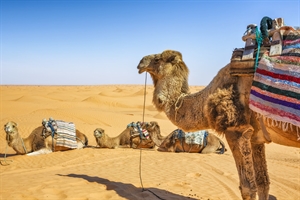About one third of the world’s land surface is desert and these arid landscapes represent true wilderness for many travellers. From the rolling sand dunes of China’s Taklamakan to the shipwreck coast of Namibia to Death Valley in California, USA, to Egypt’s iconic monuments deserts offer unforgettable experiences, bizarre wildlife and intriguing cultural artefacts.
Pilgrims undertaking the Hajj will also be visiting a desert region.
Many desert areas are rich in natural resources including oil and minerals, which makes them a destination for commercial travellers, too.
Although there are cold deserts in the polar regions, most visitors to arid regions will find high temperatures and dry air are the biggest challenges in the desert environment. Here are some tips to help you stay healthy on your desert adventure.
1. Clean water
If water is in short supply, you may be forced to turn to less than optimal sources which could expose you to water-borne diseases such as hepatitis A, typhoid, cholera, dysentery, giardia and cryptosporidiosis. To avoid these, carefully consider your water sources before you leave home.
Bring a couple of one-litre water bottles with you so you can carry clean water wherever you go. Bottled water is generally safe the world over, as are all drinks in factory-sealed bottles.
Purifying water is an attractive option in a remote area.
2. Acclimatise to the heat
You may find the extreme heat in some desert regions hard to deal with. For example, Doha in Qatar commonly experiences highs of 38°C. Or Dubai in August has an average temperature of 36°C.
It can take about ten days to acclimatise to heat. You will not be able to rush straight into a challenging regime of strenuous activity. Instead, spend a few days relaxing. Don’t be tempted to retreat to an air-conditioned room: this will just slow the process down.
3. Be aware of dehydration
If you are sweating more than normal then dehydration may become a problem, particularly if you get a case of travellers’ diarrhoea. Drink a little more than you usually would and aim for urine that is light straw-coloured. Signs of dehydration include:
- dizziness and headache
- tiredness
- dry eyes, lips and mouth
- passing urine less than three times a day, and urine may be dark in colour, too.
Dehydration can usually be treated by taking more fluids. If this doesn’t clear your symptoms, see a doctor. Untreated dehydration can be life-threatening.
4. Understand sun safety
You should avoid sunburn as it can increase your risk of skin cancer. Seek shade in the middle of the day, and cover up with clothing, a sunhat and sunglasses. You should also bring and apply plenty of sunscreen.
5. Be aware of heatstroke
Heat exhaustion occurs when the body gets too hot. The symptoms can come on very quickly. They include: faintness, tiredness, headache, muscle cramps, nausea, thirst, raised pulse, dark urine and heavy sweating.
If someone with you is suffering from heat exhaustion, lie them down in a cool place. They should remove clothing and moisten their skin to cool down. They should drink some fluids, too.
Heat exhaustion may progress to heat stroke, which can be fatal. They may lose consciousness, in which case, put them in the recovery position and get medical help.
6. Make an appointment with travel health clinic
The specialist nurses at Global Travel Clinics can give you even more advice tailored to your destination. We can also help you out with travel vaccinations in our Downtown location. Make a free appointment today and tell us all about your travel plans.


Book Online